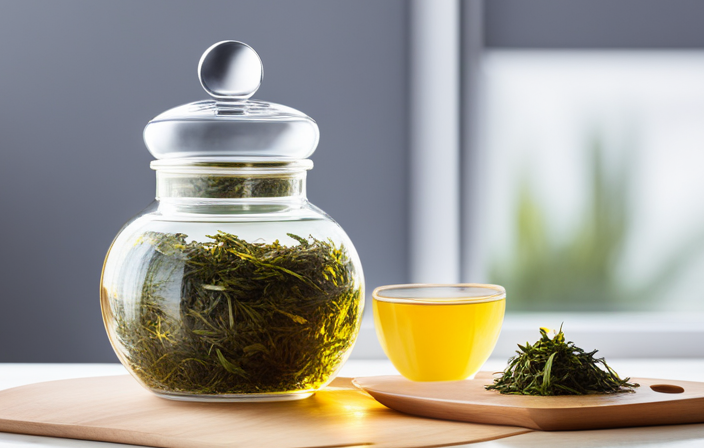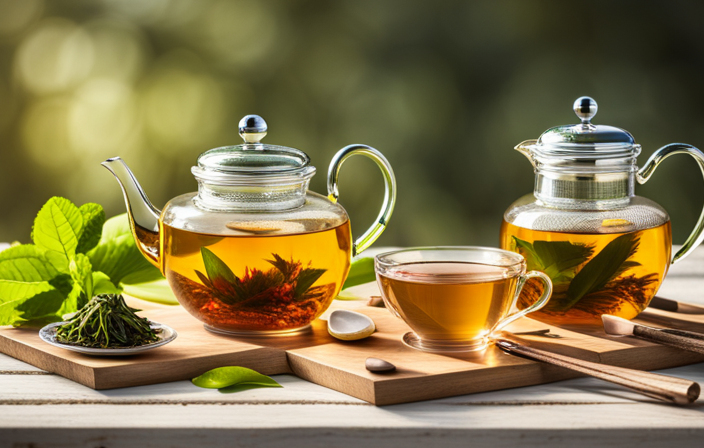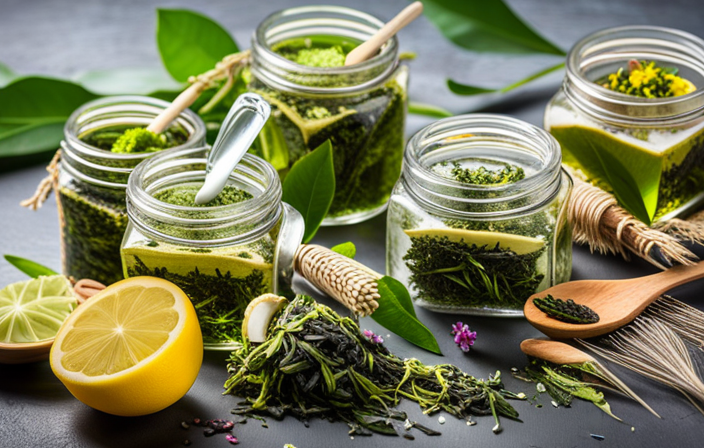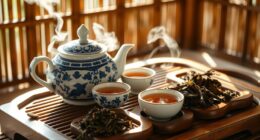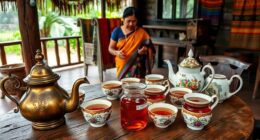As a tea enthusiast, I’ve often found myself searching for ways to keep my green tea fresh and flavorful. After countless trials and errors, I’ve finally mastered the art of preserving its delicate taste.
In this article, I’ll share my tried-and-true methods for maintaining the perfect balance of freshness and aroma. From assessing the quantity to selecting the right containers, I’ll guide you through each step to ensure your green tea remains a delightful treat with every sip.
Key Takeaways
- Properly assess and select tea by examining packaging and ensuring freshness of tea leaves
- Use proper storage techniques such as storing green tea in a cool, dark place and using airtight containers to maintain freshness
- Prevent flavor degradation by keeping green tea away from heat, moisture, and strong odors, and consuming it within a certain timeframe
- Refill and discard tea regularly, paying attention to expiration dates and storing tea in smaller quantities for freshness.
Assessing the Quantity
I need to assess the quantity of green tea leaves in my pantry before brewing a fresh cup.
When it comes to assessing the quality of green tea, it’s essential to determine its freshness. As a tea enthusiast who enjoys serving others, I understand the importance of using fresh tea leaves to brew the perfect cup.
To assess the quantity of green tea leaves, I carefully examine the packaging and check for any signs of damage or tampering. I also pay attention to the aroma, as stale tea leaves tend to lose their vibrant scent. Additionally, I inspect the color and texture of the leaves, looking for any discoloration or signs of dryness.
Selecting the Right Containers
There are several factors to consider when selecting the right containers for storing green tea, such as size and material. To ensure the freshness and quality of green tea, it’s essential to choose containers with proper sealing and airtightness. A tightly sealed container prevents air from entering and moisture from escaping, which can lead to the deterioration of the tea’s flavor and aroma.
Glass jars with rubber gaskets or metal tins with secure lids are excellent options for maintaining airtightness. Additionally, selecting a container that’s the right size for the quantity of tea will minimize air exposure.
Now that we’ve discussed the importance of proper sealing and airtightness, let’s move on to the next crucial step in preserving green tea’s freshness: keeping it cool.
Keeping It Cool
To keep green tea fresh and flavorful, it’s important to store it at the optimal temperature. Green tea should be kept cool, preferably in a cool and dark place, to preserve its delicate taste and aroma.
Optimal Storage Temperature
Storing green tea at a temperature below 32 degrees Fahrenheit helps preserve its freshness and flavor. When you open a package of green tea, you’re greeted by the invigorating aroma of freshly picked tea leaves. To maintain this delightful fragrance, it’s important to store your green tea in a cool environment.
Imagine the crispness of a cool, autumn morning, where the air is filled with the scent of fallen leaves. That’s the kind of freshness you want to preserve in your green tea. By keeping it at a temperature below freezing, you ensure that no flavor or aroma is lost. It’s like capturing the essence of nature in every sip.
Reducing Moisture Exposure
I always make sure to keep my green tea in a cool, dry place to prevent any moisture exposure. Maintaining freshness and preserving the quality of green tea is crucial to ensuring a delightful and satisfying tea drinking experience.
Moisture can be detrimental to the flavor and aroma of green tea, causing it to become stale and lose its vibrant characteristics. To minimize moisture exposure, it’s essential to store green tea in an airtight container. This helps to create a barrier against humidity and prevents the tea leaves from absorbing any unwanted moisture.
Additionally, storing green tea away from strong odors and sunlight further helps in preserving its quality. By following these simple steps, you can ensure that your green tea remains fresh, flavorful, and of the highest quality for an exceptional tea-serving experience.
Shielding From Sunlight
I’ve learned that shielding green tea from sunlight is crucial for preserving its quality. Dark storage containers are essential for blocking out harmful UV rays that can degrade the flavor and aroma of the tea.
It’s important to prioritize UV protection when storing green tea to ensure a fresh and enjoyable cup every time.
Dark Storage Containers
Fortunately, using dark storage containers is an effective way to prevent sunlight from degrading the quality of my green tea. When it comes to preserving the delicate flavors and aromas of this beloved beverage, taking dark storage precautions is crucial.
Here are three key reasons why dark storage containers are a must-have for any tea enthusiast:
-
Light protection: Dark storage containers act as a shield, blocking harmful UV rays from reaching the tea leaves. This helps maintain the tea’s natural color and prevents oxidation, which can lead to a loss in flavor and quality.
-
Temperature control: Dark containers also help regulate temperature, keeping the tea cool and away from direct heat sources. This ensures that the tea retains its freshness and prevents any unwanted changes in taste.
-
Airtight seal: Dark storage containers often come with airtight seals, preventing moisture and air from entering. This helps preserve the tea’s delicate flavors and prevents it from absorbing any unwanted odors.
Importance of UV Protection
Using sunscreen with a high SPF is essential for protecting my skin from the damaging effects of UV rays. Just like our skin, certain products also need protection from UV rays to prolong their shelf life and preserve their beneficial properties.
When it comes to skincare products, UV radiation can degrade ingredients like antioxidants, which are essential for maintaining healthy and youthful-looking skin. That’s why it’s important to choose products with UV protection, such as sunscreens or moisturizers with SPF. By shielding these products from UV rays, we can ensure that the antioxidants they contain remain potent and effective for a longer period of time. This not only helps in preserving the quality of the product, but also maximizes the benefits we receive from using them.
Now, let’s explore another aspect of maintaining product quality – avoiding flavor degradation.
Avoiding Flavor Degradation
While shielding products from sunlight can help avoid flavor degradation, it’s also important to consider other factors that may contribute to the deterioration of taste. To ensure the freshness and quality of green tea, there are three key elements to focus on:
-
Proper storage: Storing green tea in airtight containers away from heat, moisture, and strong odors prevents oxidation and maintains its delicate flavor.
-
Temperature control: Keeping green tea at a cool and consistent temperature helps preserve its aroma and prevents the growth of mold or bacteria.
-
Time sensitivity: Green tea is best consumed within a certain timeframe to maximize its flavor. Regularly rotating your tea stock ensures that you’re always enjoying the freshest brew possible.
Regular Checking Schedule
I have set up a regular checking schedule to ensure that my green tea stays fresh and flavorful.
Regular checking is essential for freshness maintenance, as green tea can lose its flavor and potency over time if not properly stored.
To maintain the freshness of my green tea, I inspect the packaging regularly for any signs of damage or exposure to light and moisture. I also check the expiration date to ensure that I consume the tea before it goes stale.
Additionally, I keep my green tea in an airtight container and store it in a cool, dark place away from direct sunlight.
Refilling as Needed
Occasionally, I find myself refilling my green tea canister to ensure I always have a fresh supply on hand. As someone who appreciates the delicate flavors and soothing qualities of green tea, it’s essential to replenish my supply regularly. By doing so, I can preserve the aroma and taste that makes green tea so enjoyable.
Here are three tips for mastering the art of keeping green tea fresh:
- Store green tea in an airtight container to prevent exposure to moisture and odors.
- Keep the tea away from direct sunlight, as it can degrade the quality and flavor.
- Consider purchasing smaller quantities of green tea at a time to ensure you’re consuming it while it’s at its freshest.
Discarding Stale Tea
Fortunately, I can confidently say that I always promptly discard any stale tea to ensure that I’m only enjoying the freshest and most flavorful cups. Discarding outdated tea is crucial in preventing flavor loss and maintaining the high quality of your brew.
When tea is left unused for a long period, it becomes susceptible to oxidation, resulting in a decrease in flavor and aroma. To prevent this, it’s essential to store your tea properly in airtight containers away from light, heat, and moisture.
Additionally, paying attention to the expiration dates on tea packaging is essential. By discarding outdated tea, you can guarantee that every cup you brew will be bursting with the delightful flavors and fragrances that green tea has to offer.
Buying Fresh Stock
To ensure I always have a sufficient supply of fresh tea, I make it a point to buy a new box every two weeks. Buying in bulk has become a popular trend among tea enthusiasts, and it has its advantages.
Firstly, I can save money by purchasing larger quantities at once. Secondly, it gives me the freedom to experiment with different flavors and varieties without worrying about running out. Lastly, buying in bulk allows me to support local tea shops and farmers by purchasing directly from them.
Once I’ve my tea, I make sure to store it in airtight bags to maintain its freshness. This helps to preserve the aroma and flavor, ensuring that every cup I brew is of the highest quality.
Maintaining Storage Conditions
Storing my green tea in a cool, dry place is essential for maintaining its freshness. Proper storage conditions can greatly impact the quality and flavor of green tea.
To ensure that my tea remains at its best, I always assess the aroma before and after brewing. A fresh and vibrant aroma indicates that the tea is still in good condition.
Additionally, preventing oxidation is crucial in preserving the tea’s delicate flavors. Exposure to air and moisture can lead to oxidation, resulting in a loss of taste and aroma.
To prevent this, I use airtight containers or resealable bags to keep my green tea protected from external factors.
Frequently Asked Questions
How Long Can I Store Green Tea Before It Becomes Stale?
I store green tea in airtight containers to prevent it from becoming stale. It’s best to follow proper storage practices to preserve the flavor. The length of time it stays fresh varies, but it’s generally recommended to consume within a year.
Can I Store Green Tea in Plastic Containers?
Storing green tea in plastic containers affects its freshness compared to glass. Temperature also plays a role in maintaining its flavor. I recommend glass containers to preserve the taste and quality of green tea.
Is It Necessary to Refrigerate Green Tea to Keep It Fresh?
Refrigerating green tea can help keep it fresh, but it’s not necessary. The pros of refrigeration include prolonging freshness and preventing oxidation. However, the cons are that it can alter the flavor and absorb odors from other foods.
Can I Use Glass Containers to Store Green Tea?
Yes, glass containers can be used to store green tea, but ceramic containers are preferred. The best storage method for green tea is to keep it in an airtight container, away from light and moisture.
How Often Should I Check on My Stored Green Tea to Ensure It Is Still Fresh?
I check my stored green tea regularly to ensure it stays fresh. It’s important to maintain the quality by using proper storing techniques, like airtight containers and keeping it away from light and moisture.
Conclusion
In conclusion, mastering the art of keeping green tea fresh requires assessing the quantity, selecting the right containers, and maintaining storage conditions.
By keeping it cool, shielding it from sunlight, and regularly checking the tea, you can ensure its freshness. Remember to refill as needed and discard stale tea to maintain the best flavor.
By buying fresh stock and following these tips, you can enjoy a delightful cup of green tea that will leave you feeling refreshed and invigorated.
Cheers to the art of tea!

